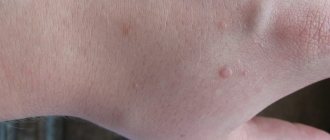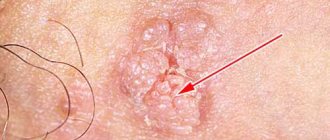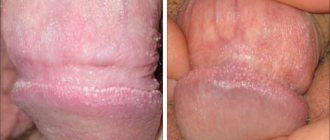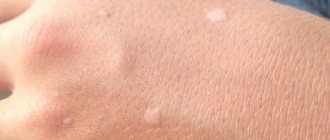The essence of the problem
Condylomas are small growths on the skin 2-6 mm in diameter. They have a thin stem with which they are attached to the skin.
Sexually transmitted HPV is to blame for their origin. Not all strains of the virus cause cell hyperplasia, but only those that can trigger the development of cancer. Types 16, 18, 11, 6, 33 are considered the most oncogenic.
The danger of HPV is that it is able to change the DNA of healthy cells by integrating into them. Cells begin to develop incorrectly, hyperplasia occurs. Condylomas on the head are the result of uncontrolled proliferation of the epithelium.
Papillomavirus enters the body in the following ways:
- During sexual intercourse. This can happen during genital, oral, anal contact. By the location of condylomas, you can understand where the virus penetrated the skin. During traditional sex, condylomas in men are located on the head of the penis, foreskin, and inside the urethra. If there was anal contact, then the warts are localized around the anus, in the rectum. After oral sex, growths may appear on the mucous membranes of the mouth, tongue, and lips.
- When kissing. The papillomavirus is also found in saliva, so transmission through this method is possible.
- Contact and household path. It is considered the rarest, infection occurs through the use of common hygiene products (towels, washcloths). Then the condylomas are localized on the surface of the skin.
Symptoms of the disease
Genital condyloma in men has a number of features related to the location and symptoms of the disease. Without treatment, it can occur in several scenarios, depending on the level of a person’s immunity:
- Self-healing. The external manifestations of the disease disappear, and the virus itself goes into a latent state. At the same time, a person remains its carrier and is capable of infecting others through both sexual and household contact.
- Absence of any dynamics during the course of the disease. A delicate balance of power is established between the papillomavirus and the body’s immune system.
- A gradual or rapid increase in the number of papillomas, their spread to new areas of the body.
- The most negative scenario for the development of the disease is when genital warts in men enter the malignant stage.
initial stage
It is quite easy to detect the disease at the initial stage: its main symptoms are characteristic growths that appear on the skin. Initially, when infected, the papilloma virus behaves secretly, being in a dormant state until the moment when the human body’s immunity is weakened for some reason. After this, the mechanism of active reproduction of the pathogenic virus is launched, which affects the cells of the skin. Usually the growths are concentrated in the intimate area - on the pubis, perineum, genitals, anus.
The effect of papillomavirus on epithelial cells leads to their uncontrolled division, as a result of which tumor-outgrowths in the form of condylomas arise. They are usually localized in the area through which the infection occurred. So, with the sexual form of infection, papillomas appear on the pubic part , affecting, among other things, the genitals - the penis and scrotum. After the first signs appear, the disease can develop, without adequate treatment, according to one of the scenarios described above.
Classification
Due to HPV infection, different types of condylomas can form:
- Flat condylomas . They have a small size from 2 to 6 mm, reddish-brown color. Their danger is that they grow inside the epidermis, capturing the deeper layers. Outwardly, warts are not very noticeable, so men do not take this problem seriously. Flat condylomas more often than others degenerate into a malignant tumor.
- Condylomas lata . Unlike flat ones, they have a wide base. Flat warts appear as a result of HPV, stage 2 syphilis.
- Hyperplastic condylomas . The growths grow, each wart has the end of a blood vessel.
- Genital warts . Warts are small in size, up to 3 mm, and do not differ in color from the skin. Many such growths form on the head, they grow, uniting into one large focus.
- Giant condylomas (Boucher-Levenshtein tumor). It occurs when warts grow rapidly, when they merge into one large one that looks like a head of cabbage. Then a purulent secretion with an unpleasant odor appears on the tumor, and ulcers form. Giant condyloma is a precursor to squamous cell carcinoma.
- Erythroplasia of Keir . One large, voluminous red spot with clear boundaries forms on the penis. When pressed, pain occurs. A bacterial infection often occurs and ulcers form.
- Bowenoid papulosis . Many small, dark brown condylomas appear on the head of the penis. The surface of the papule is rough; when infection occurs, redness and pain on palpation begin. Such condylomas are considered a precancerous condition.
What are the treatment options for condylomas planus?
The most common methods of treating growths are:
Electrodestruction
Cryotherapy. Freezing flat condylomas with liquid nitrogen is performed. The tissue dies after the procedure, and the unwanted growth disappears on its own.- Laser therapy. Flat condyloma is irradiated with a laser beam, which destroys pathological tissue.
- Electrical destruction. Flat condylomas are cauterized with electric current. The disadvantage of this method is that scars remain after the intervention.
- Chemical destruction. They use potent drugs such as Solcoderm, Condilin or Fereson. The disadvantage of this method is that it is not always effective.
Radio wave therapy
Radio wave therapy. The Surgitron device is used. Its effect does not leave scars on the skin.- Argon plasma ablation. The procedure has several advantages, the main ones being non-contact manipulation and the inability to damage the uterine cervix. Patients tolerate the operation easily.
- Antisyphilitic drugs. Used in the medical treatment of flat condylomas.
Drug treatment
To destroy the papilloma virus, the patient is prescribed antiviral drugs.
The most effective among them are:
Cycloferon
Viferon. The active component of the ointment is interferon. It is recommended to treat the affected areas with the product several times a day. The drug has minimal contraindications and allows you to get rid of flat condylomas in a week. For internal growths, it is advisable to use rectal suppositories of the same name for pathology.- Cycloferon. Available in ampoules for injection. The product strengthens the immune system and helps resist viral attacks.
- Acyclovir
Bleomycin. The action of the drug is aimed at suppressing the viability of the virus. A drug is prescribed against the development of various tumors. - Isoprinosine. The drug inhibits the virus, stopping its development, and strengthens the immune system.
- Acyclovir. An antiviral drug used to treat patients of different age categories. Changes the DNA of pathological cells. Disadvantage: it is addictive, so the treatment course should not last more than 10 days.
- Feresol. A cauterizing liquid that destroys protein compounds in affected cells. To remove small growths, it is enough to lubricate flat condylomas with the drug once. Caution is required as there is a high risk of burns.
It is advisable to carry out therapy for flat condylomas in a hospital setting. Although there are home recipes for removing growths, their components can only affect visible areas of the lesion.
It is difficult for the patient to get to hidden areas on his own, and there is a high probability of infection, which will provoke the development of the inflammatory process.
Causes
After entering the body, HPV is not always activated. If a man has good immunity, he can destroy viruses. But more often than not, the papillomavirus lies dormant inside the body, waiting for the body’s defenses to decline.
As soon as antibodies stop coping with pathogenic microorganisms, a man begins to form genital warts, most often they are localized on the head of the penis.
Provoking factors are:
- Hypothermia.
- Infectious diseases.
- Prolonged stress.
- Chronic fatigue.
- Poor nutrition with lack of vitamins.
- Bad habits that reduce immunity (alcohol, smoking).
- Promiscuous sexual intercourse.
Symptoms
After HPV enters the body, the disease goes through several stages:
- Small single warts about the size of a pinhead are formed.
- Then the warts increase in size and new ones appear.
- Condylomas merge, forming large lesions.
- Without proper treatment, the tumors increase in size, spread to other areas, and begin to bleed.
In addition to the external defect, condylomas cause other unpleasant sensations:
- Pain, burning during sexual intercourse.
- Bleeding due to friction with clothing.
- Pain when pressed.
- If condylomas are located in the urethra, there may be discomfort during urination.
Condylomatosis during pregnancy
HPV, which provokes the development of condylomatosis, is often activated during pregnancy. If condylomas existed before, then during this period they can increase and grow.
Related article:
What causes papillomas to appear on the head?
The main reason for this behavior of the virus is hormonal changes and a decrease in the body’s immune defense.
Treatment of condylomatosis during pregnancy is selected by the doctor individually, as there may be a threat to the fetus. If condylomas do not interfere with the mother’s life, then treatment is postponed until childbirth. If there are neoplasms in the vagina and on the cervix, then their removal is also decided on an individual basis.
Cesarean section delivery is not always chosen, even though the baby may become infected with the virus during a natural birth.
Danger of disease
Many men underestimate the seriousness of the pathology and do not consult a doctor if they find growths on the head. However, the appearance of condylomas is a signal that HPV has begun to progress.
If left untreated, men develop the following complications:
- Deterioration in the quality of sexual life due to painful sensations.
- Erection problems.
- Inability to conceive a child. HPV has a detrimental effect on all cells, including reducing sperm activity.
- Phimosis (narrowing of the foreskin) forms. It becomes impossible to expose the head of the penis; this is fraught with tissue necrosis.
- The risk of developing cancer increases.
In addition, a man is a carrier of papillomavirus, he transmits it to his partner. For a woman, the consequences can be no less dangerous: infertility, cervical cancer, bleeding during childbirth. Also, when passing through the birth canal, the child becomes infected with the virus.
Why are they dangerous?
Condylomas do not cause physical discomfort to a man: redness, itching and burning, in most cases, are absent. But despite the absence of obvious symptoms, such skin growths can pose a hidden threat.
The main danger of condylomatosis is the possibility of degeneration of condyloma into a tumor of a malignant nature . The most oncogenic are genital warts, which are provoked by human papillomaviruses of high oncogenic risk.
In total, HPV has more than two hundred types, but the most dangerous are viruses numbered 6, 11, 16, 18, 33 . Another risk lies in the possibility of infecting a sexual partner, since in women the human papillomavirus can cause cervical cancer.
Condylomas in women are more likely to develop into cancer than in men.
Diagnostics
The doctor makes an initial diagnosis based on the patient’s external signs and complaints. However, it is necessary to make sure that condylomas on the head are a consequence of HPV and not other sexually transmitted diseases. You should also identify all areas where warts are located.
To do this, the following examinations are prescribed:
- Blood test for syphilis.
- PCR (polymerase chain reaction). It allows you to detect pathogens of other sexually transmitted diseases. True, it is impossible to determine the strain of papillomavirus using PCR.
- If there is a suspicion of the location of condylomas inside the urethra, urethroscopy is performed.
- To detect cancer at an early stage, it is necessary to do a blood test for tumor markers.
- If condyloma is suspected of degenerating into cancer, a biopsy is necessary. A small piece of tissue is collected and sent for histology.
What symptoms indicate the presence of flat condylomas?
Flat condylomas in the vagina
Female flat condylomas are difficult to identify when they are located inside the genital tract, since such growths do not manifest themselves. Only at an advanced stage of the pathology do strange discharges begin.- It is easier to detect growths in men because they are more likely to affect the foreskin of their penis. At the same time, the stronger sex is bothered by itching, inflammation of the mucous membranes and redness of the skin. When condylomas are in the urethra, going to the toilet causes a burning sensation.
Treatment
Treatment of condylomas on the head includes two stages:
- Removing growths.
- Destruction of the human papillomavirus.
Fighting the virus
Unfortunately, it is impossible to completely cure HPV. With the help of properly selected means, they stop the spread of the virus and activate the body’s strength to fight the disease. In this way, it is possible to achieve stable remission and ensure that condylomas do not form again.
The fight against papillomavirus is carried out using the following groups of drugs:
- Immunomodulators . Interferon-based products are usually used (Viferon, Genferon, Intron-A). These medications are used in the form of injections and suppositories. At the same time, they are used in the form of ointments, treating the affected areas.
- Antiviral (Isoprinosine, Galavit, Acyclovir, Novirin). These agents fight the virus at the cellular level by changing its DNA. The drugs also have an immunomodulatory effect.
One of the most effective remedies for condylomas is Gepon. It is produced in powder form for preparing a suspension. The suspension is taken orally and the affected areas are treated. The medicine produces antibodies to the virus in the body, due to which inflammation goes away, swelling is relieved, and redness is reduced.
If there is a danger of a bacterial infection, antibacterial ointments help fight it:
- Salicylic acid . Destroys pathogenic bacteria, relieves inflammation, pain, swelling.
- Oxolinic . It has a detrimental effect on viruses, but it must be used within 3 months.
Destruction of condylomas
To get rid of condylomas, the following methods are used:
- Electrocoagulation . Warts are cauterized with electric current, the procedure is carried out under local anesthesia. The disadvantage of this method is the high level of trauma and the appearance of scars.
- Cryodestruction . The formations are exposed to liquid nitrogen, achieving necrosis of condyloma tissue. After this, the growths disappear.
- Laser therapy . The growths are burned out using a laser beam. This method is the least traumatic and painless. However, there is a risk of relapse due to incomplete removal of the changed tissue.
- Chemodestruction . Condylomas are treated with chemicals (Solcoderm, Condilin, Epigen-gel). These products contain acid; as a result of its action, the growth necrotizes and falls off. This method is effective only against small warts; it is impossible to eliminate large condylomas with the help of drugs.
- Removal of tumors surgically . This treatment is carried out if the growths are large and have grown deep into the skin layers. If malignant cells are found in warts, surgical removal is the only effective method.
Folk remedies
It is possible to remove small condylomas on the head using traditional medicine. Before use, you should consult your doctor and make sure you are not allergic to folk remedies.
The following methods help against warts:
- Rub with garlic. This must be done carefully so as not to cause a burn to the skin or mucous membranes.
- Cauterization of warts with celandine juice.
- Compress made from onions soaked in vinegar. The onion is tied to the location of the growths overnight. Usually the formations disappear after 7 days of treatment.
- A mixture of flour and vinegar, the resulting slurry should be applied to the warts, wait until completely dry, and rinse with water.
Drug treatment of anal warts in men
It has been proven that exposure to HPV reduces the effectiveness of local immunity.
Therefore, the regimen must include a local immunomodulatory component.
When condylomas are localized in the perianal area, skin of the perineum and groin, they are treated with Panavir ointment or gel at least 5 times a day for 10 days.
When the process moves to the rectum, then suppositories for rectal use “Genferon” are connected, twice a day for 10 days.
If you have to deal with large Buschke-Levenshtein condylomas, interferon injections are allowed under the base of the condyloma or directly into its thickness.
Immediately after drug immunotherapy, it is recommended to remove the tumor.
With a repeated drug course after destruction or excision.
The strengthening course must include a vaccine against the main oncogenic HPVs.
Prevention and prognosis
To prevent genital warts from appearing again, preventive measures should be followed:
- Eat right, take vitamins.
- To refuse from bad habits.
- Avoid hypothermia, physical stress, and emotional stress.
- Treat infectious diseases in a timely manner, preventing them from reducing the body’s defenses.
Unfortunately, it is impossible to completely get rid of HPV. But it is possible to eliminate its external manifestations - condylomas. With proper treatment, warts can be eliminated forever. In the future, a man should only maintain his immunity.
Condylomas on the head in men are an unpleasant phenomenon. In addition to being a cosmetic defect, they can cause serious health problems. The most dangerous consequence is cancer. Timely diagnosis and correct treatment will help prevent complications.
Possible complications
The danger of condylomas in men lies in their effect on the functioning of the body. The consequences and complications of such warts are as follows:
- a sharp decrease in immunity;
- changes in the DNA of cells of the epithelial layer, which is fraught with the formation of malignant tumors; Men may develop penile cancer;
- injury to condylomas and the likelihood of secondary infection, which can lead to blood poisoning.
The best way to avoid complications is to observe the prevention of the development of condylomatosis and contact a specialist if atypical neoplasms are detected on the skin and mucous membranes.











